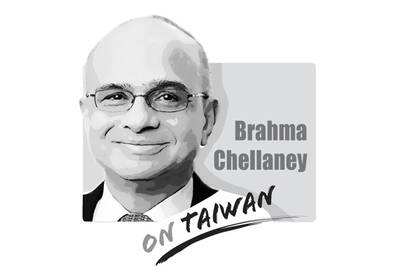Regardless of why the US government has been prevaricating on the sale of 66 F-16 fighter aircraft to Taiwan, it is increasingly apparent that the road ahead for weapons procurement from the US is going to be bumpy.
As China's military threat is not becoming any less severe, Taipei must find a way to pull itself out from this quandary. The solution is fairly simple -- shop elsewhere. Luckily, there is no shortage of companies and states eager to sell weaponry to countries in need.
When it comes to advanced fighter aircraft, two alternatives to the F-16 come to mind: Dassault's Rafale Multi-Role Combat Fighter and the Euro-fighter Typhoon. Both aircraft could meet Taiwan's defense needs, from air superiority to close air support. While both aircraft were initially developed for Europeans, their manufacturers have actively sought clients elsewhere.
So far, India, Libya and Switzerland have shown interest in acquiring the Rafale, which in recent years has lost out on South Korean and Moroccan bids to US-made F-15Ks and F-16s respectively. As for the Typhoon, Saudi Arabia has confirmed it will purchase 72 aircraft for ?4.43 billion (US$9.03 billion) and Japan has expressed an interest in making it its next-generation fighter aircraft, as have India and Pakistan.
But the acquisition of new aircraft involves more than just platforms. Cost, performance and interoperability must all be considered.
In terms of cost, the price tag per Rafale is approximately 47 million euros (US$66.5 million), the Typhoon is US$125.6 million, while the F-16C/D is US$45.5 million. In that respect, the F-16 has a clear advantage over its competitors.
But when it comes to performance, the latter is falling behind technologically, something that even US Air Force Lieutenant General Bruce Wright, the commander of US forces in Japan, admitted last month (Taiwan did seek the more advanced F-35, but the request was turned down by Washington).
Last is interoperability, the curveball often thrown by the US defense industry to defeat its competitors in the weapons market. With obvious exceptions, any country today that purchases weapons will seek to obtain platforms that can be seamlessly integrated with US capabilities -- something Taiwan would certainly desire in the advent of military confrontation in the Taiwan Strait.
Aware of this requirement, non-US defense contractors have ensured that their models are fully capable of operating alongside US weaponry. In other words, they are all NATO-compatible, as the successful use of the Rafale in the US-led mission in Afghanistan has shown. As such, if Taiwan were to purchase the Rafales or Typhoons rather than F-16s, interoperability with existing systems and with US systems in the region should not be a problem.
There would be other advantages to widening the list of potential defense contractors. For one, increased competition means that prices would likely go down. It would also diminish Taiwan's unhealthy reliance on the US to meet its defense needs, which puts it at risk when, as now, politics have a detrimental impact on defense acquisitions.
Lastly -- and perhaps most importantly -- the more countries that vie for Taiwanese defense money, the more complaints Beijing will have to make about the "unacceptable" sale of weapons to Taiwan. So far, it has only had to deliver complaints to the US.
In other words, by shopping around, Taiwan would prompt Beijing to make more belligerent demands with more countries -- perhaps alienating them in the process -- which could prove politically beneficial.

China badly misread Japan. It sought to intimidate Tokyo into silence on Taiwan. Instead, it has achieved the opposite by hardening Japanese resolve. By trying to bludgeon a major power like Japan into accepting its “red lines” — above all on Taiwan — China laid bare the raw coercive logic of compellence now driving its foreign policy toward Asian states. From the Taiwan Strait and the East and South China Seas to the Himalayan frontier, Beijing has increasingly relied on economic warfare, diplomatic intimidation and military pressure to bend neighbors to its will. Confident in its growing power, China appeared to believe
Taiwan-India relations appear to have been put on the back burner this year, including on Taiwan’s side. Geopolitical pressures have compelled both countries to recalibrate their priorities, even as their core security challenges remain unchanged. However, what is striking is the visible decline in the attention India once received from Taiwan. The absence of the annual Diwali celebrations for the Indian community and the lack of a commemoration marking the 30-year anniversary of the representative offices, the India Taipei Association and the Taipei Economic and Cultural Center, speak volumes and raise serious questions about whether Taiwan still has a coherent India
Recent media reports have again warned that traditional Chinese medicine pharmacies are disappearing and might vanish altogether within the next 15 years. Yet viewed through the broader lens of social and economic change, the rise and fall — or transformation — of industries is rarely the result of a single factor, nor is it inherently negative. Taiwan itself offers a clear parallel. Once renowned globally for manufacturing, it is now best known for its high-tech industries. Along the way, some businesses successfully transformed, while others disappeared. These shifts, painful as they might be for those directly affected, have not necessarily harmed society
Legislators of the opposition parties, consisting of the Chinese Nationalist Party (KMT) and the Taiwan People’s Party (TPP), on Friday moved to initiate impeachment proceedings against President William Lai (賴清德). They accused Lai of undermining the nation’s constitutional order and democracy. For anyone who has been paying attention to the actions of the KMT and the TPP in the legislature since they gained a combined majority in February last year, pushing through constitutionally dubious legislation, defunding the Control Yuan and ensuring that the Constitutional Court is unable to operate properly, such an accusation borders the absurd. That they are basing this